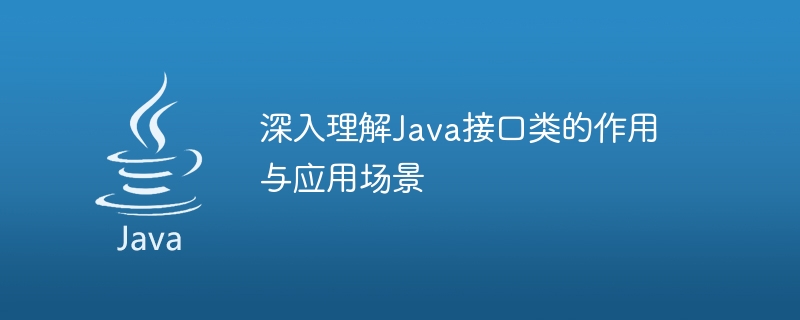Home >Java >javaTutorial >Research on the role and application scenarios of Java interface classes
Research on the role and application scenarios of Java interface classes
- WBOYWBOYWBOYWBOYWBOYWBOYWBOYWBOYWBOYWBOYWBOYWBOYWBOriginal
- 2024-02-02 16:36:21849browse

In-depth understanding of the role and application scenarios of Java interface classes
Introduction:
Java interface is an important language feature used to define between classes A set of public methods and constants. Interfaces provide a mechanism to achieve polymorphism, allowing different classes to implement the same interface, so that the implementation logic can be replaced without changing the original code. This article will deeply explore the role and application scenarios of Java interface classes, and further deepen understanding through specific code examples.
1. The role of interface classes
- Define the behavioral specifications of a class:
Interface classes are mainly used to define the behavioral specifications of a class, that is, they describe a set of methods and constants. But there is no specific implementation code. The difference between an interface and an abstract class is that an interface can only define constants and abstract methods, but cannot define instance variables and concrete method implementations. By implementing an interface, you can force subclasses to follow the specifications defined by the interface and implement the methods defined by the interface in the subclass. - Achieve polymorphism:
The Java interface provides a mechanism to achieve polymorphism. Polymorphism means that when a parent class reference can point to a subclass object, when a method with the same name is called, the corresponding method logic will be executed based on the specific object type. By implementing interfaces, different classes can have different implementation logic, thereby achieving polymorphism. - Reduce the coupling of classes:
Interface classes can effectively reduce the coupling between classes. By abstracting public methods and constants into interfaces, the coupling between classes is reduced to a minimum. Each class only needs to follow the specifications defined by the interface and does not need to care about specific implementation details, thereby improving the maintainability and safety of the code. Scalability.
2. Application scenarios of interface classes
- Define the callback function:
The callback function refers to calling a preset method when an event occurs. . Through the interface class, the specification of the callback function can be defined, and then the specific class implements the interface and passes the implementation method to the method that requires callback. In this way, when an event occurs, the corresponding callback method can be called to perform specific logic.
The following is a simple example that defines an interface class Listener and has a callback method onEvent(). The specific class implements the interface and implements specific logic through the callback:
public interface Listener {
void onEvent();
}
public class EventSource {
private Listener listener;
public void registerListener(Listener listener) {
this.listener = listener;
}
public void fireEvent() {
// 触发事件
if (listener != null) {
listener.onEvent();
}
}
}
public class EventListener implements Listener {
@Override
public void onEvent() {
// 处理事件的逻辑
System.out.println("处理事件");
}
}
public class Main {
public static void main(String[] args) {
EventSource eventSource = new EventSource();
eventSource.registerListener(new EventListener());
eventSource.fireEvent();
}
}- Implement subclass replacement of interface:
Interface class can implement the mechanism of class replacement. Specifically, when a class implements an interface, it can replace the interface where it is used, thereby achieving code flexibility and scalability.
The following is an example that defines an interface class Fruit and its two implementation classes Apple and Banana. Where you need to use the Fruit class, you can use Apple or Banana instead, thereby realizing class replacement:
public interface Fruit {
void eat();
}
public class Apple implements Fruit {
@Override
public void eat() {
System.out.println("吃苹果");
}
}
public class Banana implements Fruit {
@Override
public void eat() {
System.out.println("吃香蕉");
}
}
public class Main {
public static void main(String[] args) {
Fruit apple = new Apple();
apple.eat();
Fruit banana = new Banana();
banana.eat();
}
}- Realizing multiple inheritance:
In Java, a class can only inherit one parent Class, but can implement multiple interfaces. Interface classes can be implemented through multiple inheritance, thus achieving the effect of multiple inheritance. This method is very useful when designing complex class systems, and can avoid the complexity and coupling of class inheritance structures.
The following is an example that defines two interface classes Animal and Flyable to achieve the effect of multiple inheritance:
public interface Animal {
void eat();
}
public interface Flyable {
void fly();
}
public class Bird implements Animal, Flyable {
@Override
public void eat() {
System.out.println("吃虫子");
}
@Override
public void fly() {
System.out.println("飞上天空");
}
}
public class Main {
public static void main(String[] args) {
Bird bird = new Bird();
bird.eat();
bird.fly();
}
}Conclusion:
In Java, the interface class is A very important language feature that has the function of defining class behavior specifications, implementing polymorphism, and reducing class coupling. This article provides an in-depth discussion of the role and application scenarios of interface classes through detailed code examples. I hope that readers can have a more in-depth understanding and application of Java interface classes by studying this article.
The above is the detailed content of Research on the role and application scenarios of Java interface classes. For more information, please follow other related articles on the PHP Chinese website!
Related articles
See more- How does php use curl method to request Java interface? Two methods for php to request Java interface using curl method
- Can java interfaces be inherited?
- What is the format of using default methods in java interface
- Java interface creation tips and solutions to common problems
- Basic syntax and usage of Java interfaces

